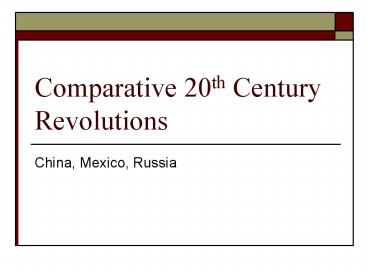Comparative 20th Century Revolutions - PowerPoint PPT Presentation
1 / 23
Title:
Comparative 20th Century Revolutions
Description:
Comparative 20th Century Revolutions China, Mexico, Russia * Peasants-- urbanization * Euopean imperialism crisis of capitalism due ot IR China communist part ... – PowerPoint PPT presentation
Number of Views:222
Avg rating:3.0/5.0
Title: Comparative 20th Century Revolutions
1
Comparative 20th Century Revolutions
- China, Mexico, Russia
2
Why?
- Rural discontent
- Industrial revolution impact class gaps, world
markets, colonial independence movements - Global economic slump
- World wars
- Ideological developments
- Resentment of Western cultural and economic
hegemony shows up as nationalism
3
Intellectual Roots in Liberalism Progress
history, Nationalism and Socialism
- Marxist Ideology (urban workers not peasants)
- Bolsheviks (Marxist-Leninism)
- But in Mexico, different model of revolutionary
change - Initally, liberal ideology of constitutions,
representation and free elections - Agrarian reform, redistribution of land as basis
of wealth - Later, Mao in China
- Peasantry key to revolutionary change
4
Leadership
Sun Yat-sen
Lenin
Villa and Zapata in Presidential Palace
5
Intellectual Roots of Leaders
- Western education
- Madero
- Sun Yat Sen
- Lenin
6
Causes Mexican Revolution
- Class gap and foreign ownership
- Mexico 1 owned 85 of land
- 95 of population were landless peasants
- American and British owned silver mines,
plantations, railroads, ranches - Peasants locked into debt relationships with
landowners - Devaluation of Mexican culture
7
Mexico
- Prelude to Revolution
- Diaz
- Madero
- Reform Supporters
- Pancho Villa
- Venustiano Carranza
- Emiliano Zapata
- Alvaro Obregon
- Madero won 1912 election based on land reform
(assassinated in 1913)
8
MexicoMilitary Phase
- Agrarian Revolutionaries
- Zapata
- Tierra y Libertad
- Leader of landless peasantsRobin Hood
- Plan of Ayala redistribute land of wealthy
(Hacendados) and seize foreign ownership of local
resources - Pancho Villa
9
Mexico- Reform Phase
- Succession of Presidents (military caudillos)
- Huerta
- Carranza
- Obregon
- (Calles)
- (Cardenas)
10
Constitution Convention 1917
- More liberal than Carranza intended and initially
not fully implemented - Article 3 Secular Education
- Article 27 Land reform (nation is the original
owner of all land, water and subsoil) - Article 123 Labor reform
- Article 130 Restrictions on Church
11
Mexico- Reform Phase
- General Obregon
- Land reform
- Labor
- Education
- Indigenismo
- US relationship
- 1920 Obregon wins election (Carranza murdered)
12
Mexico- Womens Role
- Soldaderas
- In hope of social change
- Cooked and commanded troops
- Served as spies and couriers
- Shot carbines and pistols
- Fought disguised as men
- Constitution promised social reforms
- Dolores Jimenez
- Working class organization of women opposed to
Diaz
13
Motives for Mexican Revolutionaries
- We are the elements of a social movement which
will not rest until it has enlarged the destinies
of our motherland. We are the tools Destiny makes
use of to reclaim the sacred rights of the
people. We are not fighting to dethrone a
miserable murderer, we are fighting against
tyranny itself. - Mariano Azuela, The Underdogs
14
Legacy
- Mexico
- 2 million died in civil war (15 million)
- Agrarian reforms adopted
- Social programs initiated for workers and middle
class-- literacy - Constitution of 1917 social reforms promised
- Restoration of Mexican dignity, equality of
Indians, mestizos, and whites, peasants and urban
dwellers - Political party begun by Madero would dominate
Mexican politics for next 80 years. - Trotsky would find exile (and execution) in
Mexico - But dependent development continued
15
China
- Collapse of Imperial system- 1911
- Republic under Sun Yat-Sen
- 1916-1927 Warlord era
- Background
- Chinese defeat in war with Japan, 1895
- Boxer Rebellion failure 1899
- Death of Empress Dowager, 1908
16
China
- Education
- Access for girls to school, work, western ideas
- Christianity
- Decline of footbinding
- New Culture Movement
17
China- What Next?
- Resentment towards Japans 21 Demands
- May 4th Movement refusal to sign the Treaty of
Versailles - Beginning of Communist Party influence from
Russia - Growing nationalism
18
February 1917, Russia
- Tsar Nicholas lost support, forced to abdicate
- Provisional Government amidst social revolution
led by Alexander Kerensky - Radicals organized soviets
- Continued involvement in the Great War
- Prior to WWI
- Emancipation of Serfs
- Crimean War
- Russo-Japanese war
- Bloody Sunday 1905
- Creation of Duma
19
Bolshevik Message
- Peace, Bread and Land
- End to the war
- Land for the peasants
- Workers control of factories
- Self-determination for minorities
Lenin
20
Civil War in Russia
- 1917-1921
- Allied invasion, typhoid epidemic, brutal
fighting - Communists won, pulled out of the war, signed
surrender treaty, and changed name USSR. - Left Germany with only one front to fight on.
21
Russia
22
Foreign Involvement
- Two US interventions during the Mexican
revolution Poor Mexico so far from God, so
close to the United States. - ChinaSun Yet-sen had a western education, New
Culture Movement - Prior to war, foreign investment in Russia high.
- Russian Invasion by US, Britain, France and Japan
was resented (and successfully resisted) by new
Soviet state.
23
Comparisons
- Causes
- Leaders
- Foreign Involvement
- Women
- Other































